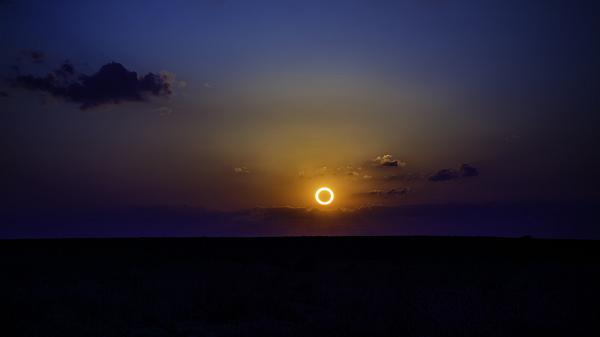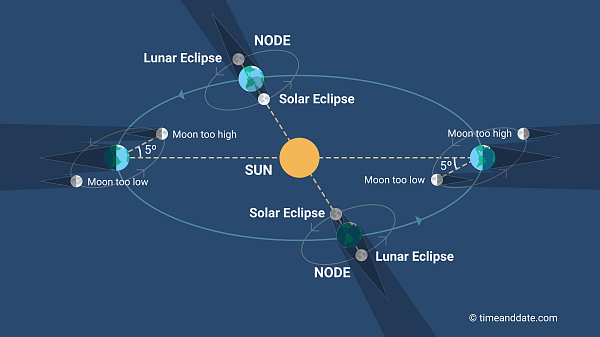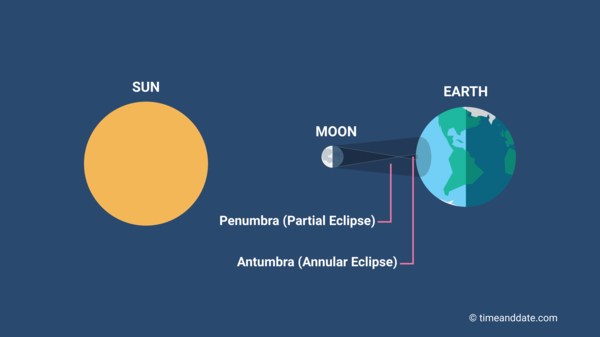What Are Annular Solar Eclipses?
An annular solar eclipse happens when the Moon covers the Sun's center, leaving the Sun's visible outer edges to form a “ring of fire” or annulus around the Moon.

Next Annular Solar Eclipse: Tue, Feb 17, 2026 … See animation
Next Eclipse: Total Lunar Eclipse – Sun, Sep 7, 2025 … See animation

The characteristic “ring of fire.”
©iStockphoto.com/ssucsy
Moon Casts a Shadow
Solar eclipses happen when the New Moon casts a shadow on Earth.
The Moon's shadow is not big enough to engulf the entire planet, so the shadow is always limited to a certain area (see map illustrations below). This area changes during the eclipse because the Moon and Earth are in constant motion: Earth continuously rotates around its axis while it orbits the Sun, and the Moon orbits Earth.
Solar eclipses are only visible from within the area where the shadow falls, and the closer you are to the center of the shadow's path, the bigger the eclipse looks.
Which cities get the most eclipses?
Annular Means Ring-Shaped
The name “annular” comes from the Latin word for ring, “annulus.” These eclipses are named for their darkest, or maximum, point even if it only lasts less than a second. If the characteristic ring of fire is visible from even just one location, the whole eclipse is called an annular solar eclipse.
However, in most places and for most of the duration, an annular eclipse looks like a partial solar eclipse. This is also the case for total solar eclipses and for the rare hybrid solar eclipses which have an annular maximum point in some locations and a total maximum point in other locations.
Astronomical terms & definitions
When Do They Happen?
Annular solar eclipses can only take place when:
- It is New Moon.
- At the same time, the Moon is at (or very near) a lunar node, so the Earth, the Moon, and the Sun are aligned in a straight (or nearly straight) line.
- The Moon is near its farthest point from Earth, called apogee, so the outer edge of the Sun remains visible as a ring of sunlight.
1. Why Not Every New Moon?
Solar eclipses are relatively rare. For any solar eclipse to take place, it has to be around New Moon, when the Sun and Earth are aligned on opposite sides of the Moon. Normally, the New Moon is invisible from Earth. The only time we can see it is during solar eclipses, silhouetted against the Sun.
2. Close to Lunar Nodes


Lunar nodes are the locations where the Moon crosses the Earth's orbital plane.
So why isn't there an eclipse every night there is a New Moon? This is because the New Moon also has to be close to a lunar node.
The plane of the Moon's orbital path around Earth is inclined at an angle of approximately 5° in relation to Earth's orbital plane around the Sun—the ecliptic. The points where the 2 orbital planes meet are called lunar nodes. When the Sun and the Moon are close enough to a lunar node to form a perfect or almost perfect line with Earth, we are in the eclipse season, which lasts around 34.5 days. In every eclipse season, there are 2 to 3 eclipses, and at least 1 of these is always a solar eclipse; at the most 2.
User images: Annular solar eclipse
3. Moon Is Far from Earth
Throughout every lunar month, the distance between our planet and the Moon varies because the shape of the Moon's orbit around Earth is elliptical, rather than circular.
The reason we can see the glowing outer edge of the Sun at the maximum point of an annular eclipse is that it happens while the Moon is near its farthest point from Earth, called apogee, when the Moon is smaller than the Sun when viewed from Earth.
What if the Moon is near perigee?
The Moon's Antumbra


The Moon's antumbra.
©timeanddate.com
Solar eclipses are caused by the Moon casting shadows on Earth. There are 3 different types of shadow that the New Moon can cast on Earth: the umbra, the penumbra, and the antumbra.
To see annularity, you must be in a location where the Moon casts the antumbra. At the maximum point, the width of the annular path is typically around 150 km (93 mi) although this can vary considerably. If you're at the center of this zone, you will see the annularity's maximum point as a perfect ring of fire. In other areas of annularity, where the Moon is not perfectly centered on the Sun, the ring has varying width.
If you're at the edge of the annularity path, you may see a broken ring of fire and–for a brief moment–a phenomenon called Baily's beads, which are little bead-like blobs of light at the edge of the Moon. These happen because gaps in the mountains and valleys on the Moon's surface allow sunlight to pass through in some places, but not in others.
Stages of an Annular Solar Eclipse
What can you see during an annular eclipse?
There are 5 distinct stages of an annular solar eclipse:
- 1st contact—partial eclipse begins: The Moon's silhouette starts becoming visible in front of the Sun's disk. The Sun looks as if a bite has been taken from it.
- 2nd contact—full eclipse, or annularity, starts: The ring of fire appears. For a few seconds just as the annularity begins, Baily's beads, which look like beads of light, can sometimes be seen at the edge of the Moon's silhouette.
- Maximum eclipse: The Moon covers the center of the Sun's disk.
- 3rd contact—annularity ends: The Moon starts moving away from the disk of the Sun. Once again, Baily's beads may be visible along the Moon's leading edge.
- 4th contact—partial eclipse ends: The Moon stops overlapping the Sun's disk. The eclipse ends at this stage.
How Long Does it Last?
Annular eclipses can last over 3 hours in locations where annularity is visible. From start to finish, the total duration of annular eclipses can be over 6 hours but not in a single location. The annularity, when only a ring of fire is visible in the sky, can range from less than a second to over 12 minutes.
Protect Your Eyes!
Never look at the Sun, eclipsed or otherwise, without proper eye protection, like eclipse glasses. The Sun’s rays can burn the retinas in the eyes leading to permanent damage or even blindness.
A safe way to watch a solar eclipse is to wear protective eclipse glasses or to project an image of the eclipsed Sun using a pinhole projector.
Earth's Distance to Sun
Earth's orbit around the Sun is also elliptical, which means that there is 1 point of the path when Earth is at its closest point to the Sun (perihelion) and 1 point when it is furthest away (aphelion). Earth's distance to the Sun also sometimes affects the type of eclipse, the duration of the eclipse, exactly how much of the Sun's disk will be eclipsed, and the size of the area on Earth where the eclipse is visible.




